Excerpts from Jim Conrad's
Naturalist Newsletter
entry dated April 1, 2022, issued from near Tequisquiapan, elevation about 1,900m (6200 ft), ~N20.57°, ~ W99.89°, Querétaro state, MÉXICO
SCARLET GUARA FLOWERING
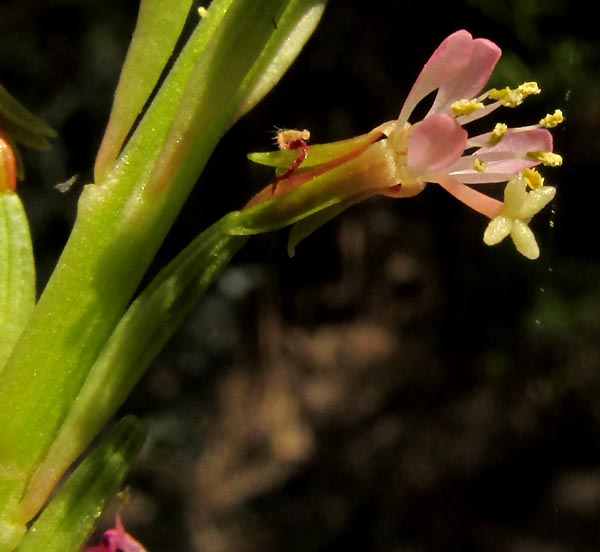
During the latter, hotter, sunnier part of the dry season, in the weedy bottom of a drainage ditch now so dried out that the ditch bottom's former mud was deeply fissured with cracks, the elegant blossom shown above made its appearance. Notice that the flower is bilaterally symmetrical, with its right side mirroring its left. From the cluster of 8 stamens amid the 4 pink petals, the drooping style thickens toward its top, suddenly flaring into a starfish-like 4-lobed stigma. The four pink petals unite into a corolla tube mostly hidden behind 4 green, turned-back sepals. All this arises atop a slender, green, lightly ribbed, cigar-shaped ovary holding close to the plant stem. All these features considered together point to the Evening Primrose Family, the Onagraceae.
Without looking closely, though, you might overlook the flower. Below you see the population of knee-high plants in which the above flower was photographed.
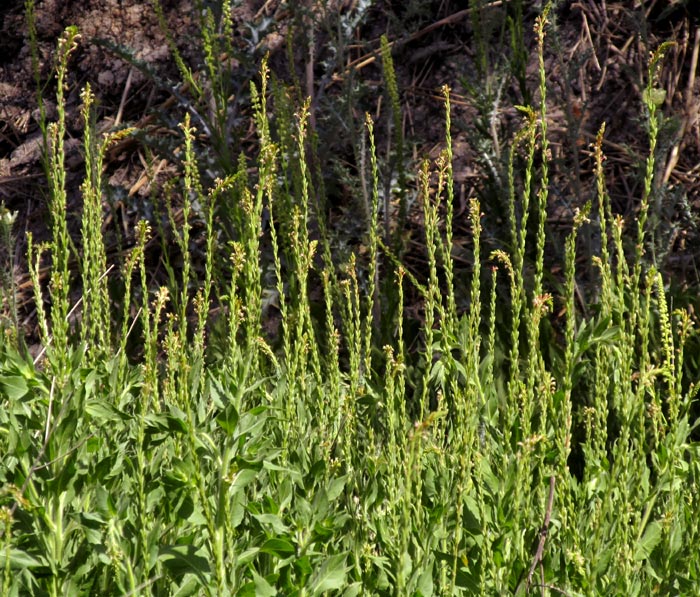
Our blossom resided near the very top of one of those plants, its immediate neighborhood shown below:
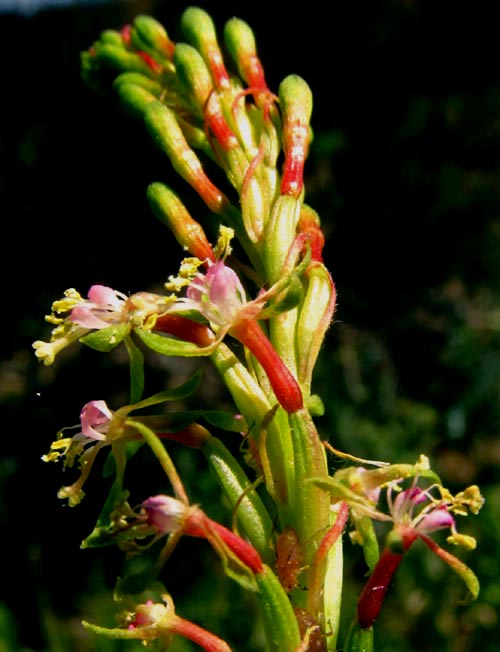
I'd been watching these plants, wondering what they were, for months. Earlier they'd formed a thick carpet of leafy rosettes typical of biennials who spend their first year gathering stored food, then on the second year bolt to form slender clusters of flowers and fruits. However, our plants' drainage ditch bottom is flooded during the rainy season, so I'm unsure about their lifecycle. At least one plant still was in its rosette form, shown below:
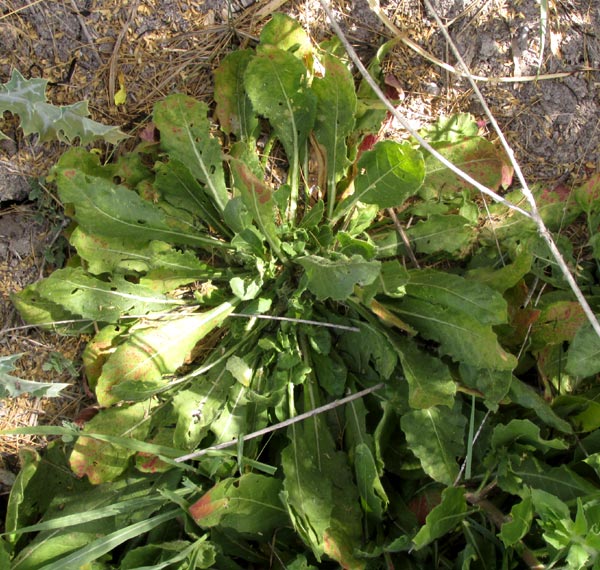
Thanks to energy stored during the plants' rosette stage, now the flowering ones had sturdy stems and robust leaves. Below, you can see that these vegetative parts were particularly long-hairy, and that tiny particles, including hapless minuscule insects, collected among the hairs:
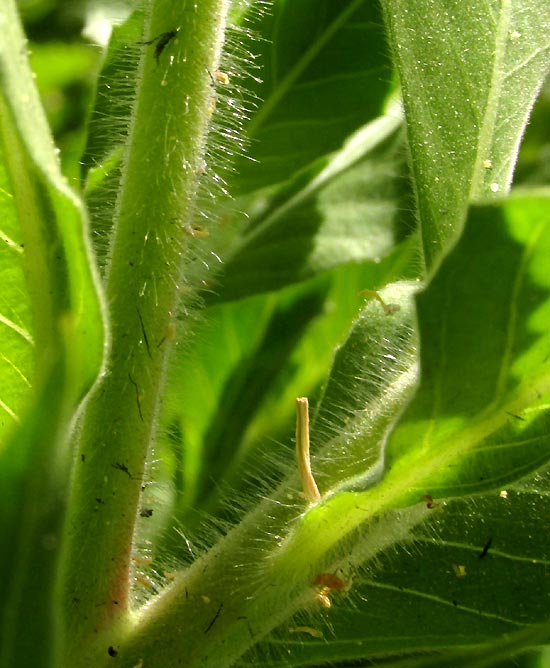
This appears to be the Scarlet Guara, OENOTHERA SUFFRUTESCENS, widely distributed from Canada all through the US, into southern Mexico. I say "appears" to be, because this is a variable species. The worldoffloweringplants.com website, apparently based where there are short summers, describes the stems as up to 10cm tall (4 inches), while the Red de Herbarios del Noroeste de México, based in Sonora, describes them as up to 1m (1 yard) tall, like ours. Our flower's anthers are shorter than those seen on blossoms on the Internet, but that may be because our plants are flowering during a very dry, hot, breezy time period.
The "Guara" in the English name comes about from our species formerly being assigned to a different genus, under the name Guara coccinea. Many websites still use that name. However, genetic sequencing has shown that Guara species are nested within the genus Oenothera, so Guara has been lumped into Oenothera.
The online Atlas de las Plantas de la Medicina Tradicional Mexicana calls our plant Hierba del Golpe, more or less "Hit Herb." In the old days people knew that if you got hit and it hurt you could mash our plant into a kind of pulp and apply it as a fomentation. If the injury was internal, you could brew up a tea of our plant along with Guaje cirial (Crescentia alata), Álamo Macho (poplar tree species) and Palo Colorado (Quercus eduardii, an oak).
entry dated April 12, 2022, issued from near Tequisquiapan, elevation about 1,900m (6200 ft), ~N20.57°, ~ W99.89°, Querétaro state, MÉXICO
SCARLET GUARA FLOWERING
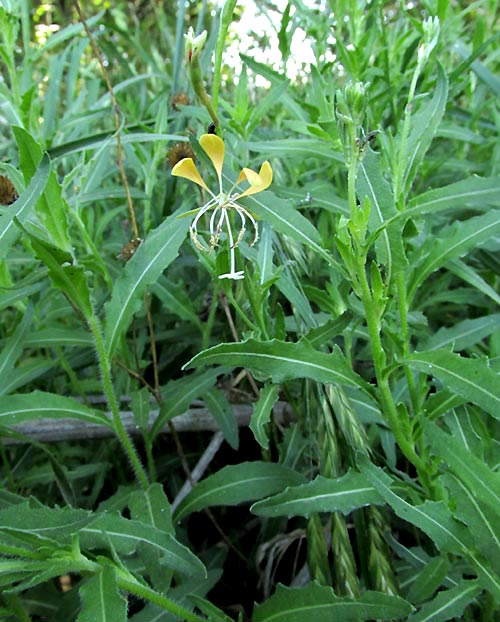
I thought this was a different species of Guara until it was run through the identification process, but it's the "Scarlet Guara," despite the yellow flower.
This coincides with the fact that if you do an image search on the Internet for the species, maybe half the blossoms that turn up are white or very pale pink. Now I understand that when the flowers first emerge from their buds, they're white, then when morning comes fade to pink and only later turn scarlet, all in the same day. Remembering that Oenothera is in the Evening Primrose Family -- flowers opening in the evening -- the whiteness of the newly opened flowers attracts night-flying moths.